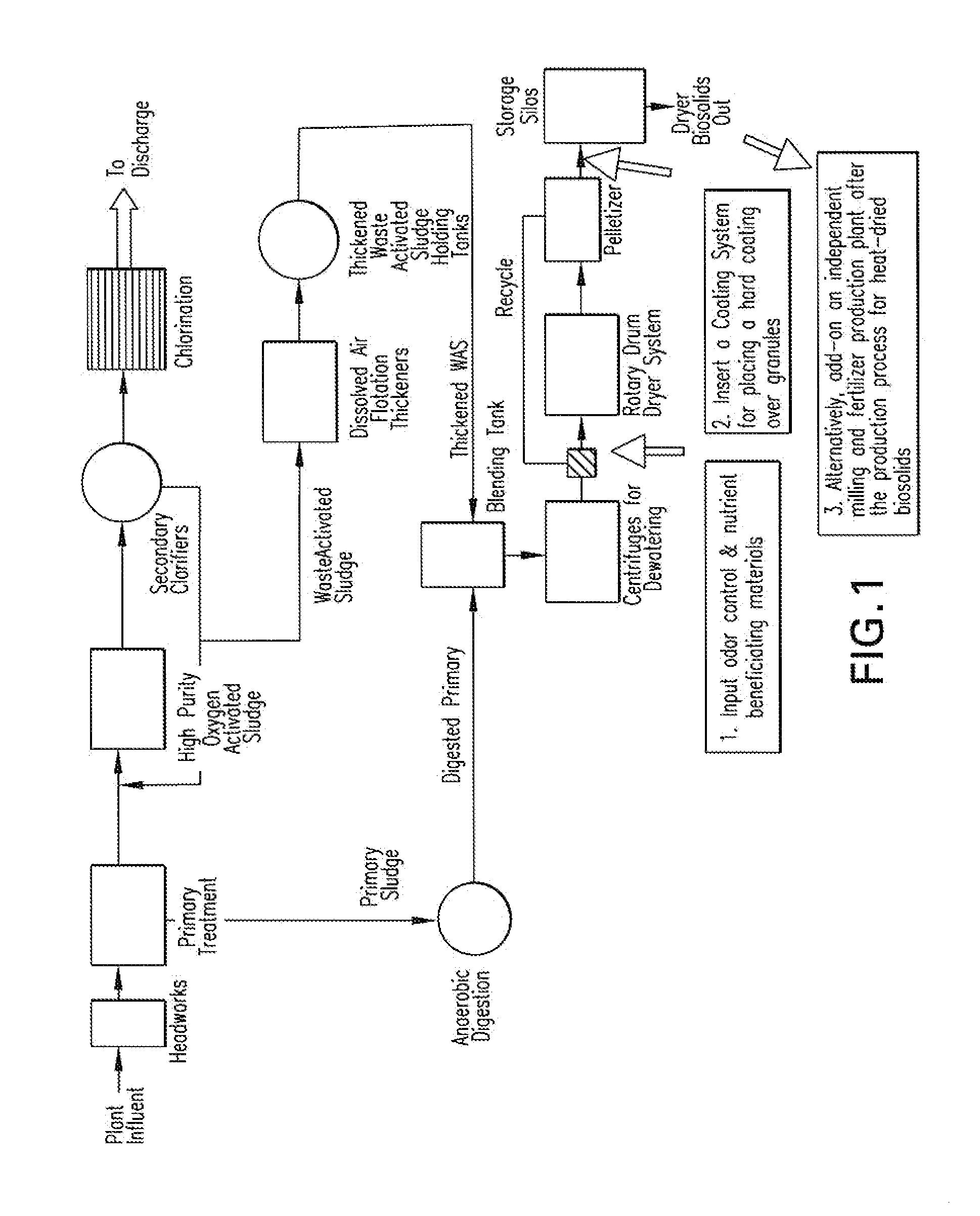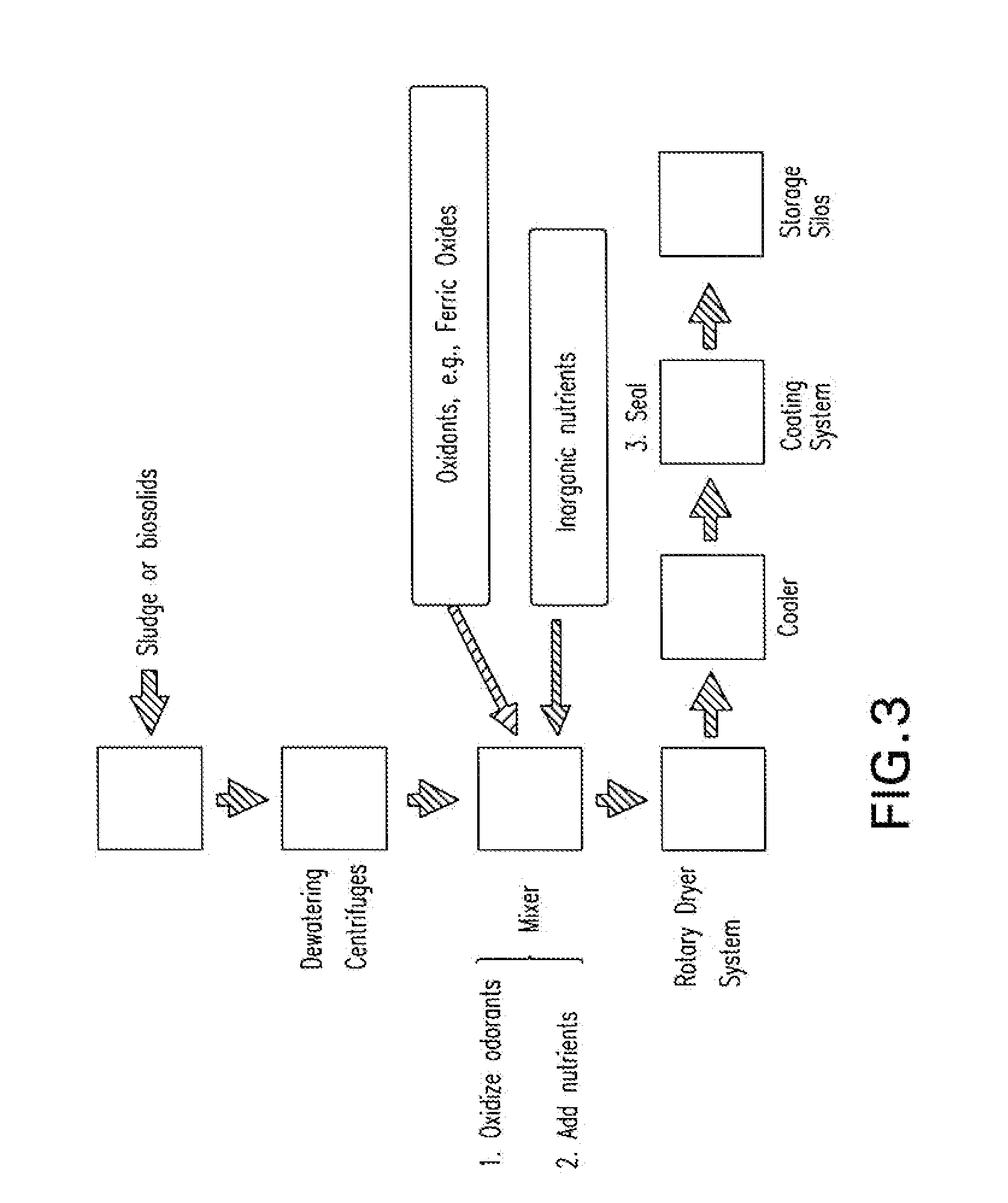Beneficiated, heat-dried biosolid pellets
a technology of biosolid pellets and beneficial bacteria, which is applied in the direction of nitrogenous fertilisers, calcareous fertilisers, sludge treatment by oxidation, etc., can solve the problems of high freight and application costs per unit of nitrogen, the serious and growing problem of sludge discharged from large-scale wastewater treatment plants, and the high investment required for sludge drying facilities
- Summary
- Abstract
- Description
- Claims
- Application Information
AI Technical Summary
Benefits of technology
Problems solved by technology
Method used
Image
Examples
first preferred embodiment
[0045]In a preferred embodiment of the present invention, finished heat-dried biosolids are removed from a municipal wastewater plant that manufactures said heat-dried biosolids and transports them to a separate manufacturing plant, preferably as close to the municipal wastewater treatment plant as possible, for milling and processing into a high nitrogen containing bioorganic fertilizer. In this preferred embodiment, milling converts the dry (80% to 100% solids, preferably 95% to 100% solids, and more preferably 98% to 100% solids) pelletized or granular heat-dried biosolids pellet into a powder which can then be further processed. As shown in FIG. 1, finished dry heat-dried biosolids pellets or granules are removed from a typical municipal wastewater treatment plant biosolids production process and taken to a separate manufacturing facility for conversion into a plant nutrient rich valuable fertilizer.
[0046]At this separate facility the process is as illustrated in FIG. 2. Nearly ...
second preferred embodiment
[0053]In a second preferred embodiment of the present invention, nutrient and odor control chemicals are inserted into the process stream within the heat-drying plant itself. This is accomplished by retrofitting existing municipal biosolids heat drying operations or manufacturing plants. The steps of the second embodiment are illustrated in FIG. 3. In FIG. 3, equipment supplied for the pellet beneficiation process are indicated in the solid or green blocks. The dewatered biosolids are conveyed to a first mixer, preferably a pugmill, as described in the preferred embodiment. The biosolids are then treated in this mixer with one or more odor control agents such as calcium ferrate as described for the preferred embodiment. The odor treated mix is then acidified in this mixer with concentrated phosphoric acid in order to control odors and commence biosolids disinfection and to facilitate production of a thixotrophic mix in the first mixer or pugmill as also described in the preferred em...
third preferred embodiment
[0055]The third preferred embodiment describes adding to the sludges or biosolids within a wastewater treatment plant manufacturing heat-dried biosolids as illustrated in FIG. 4; odor control agents such as ferrate or hydrogen peroxide followed by adding to the biosolids, nutrient materials, preferably, solid fertilizers, ammonium sulfate, ammonium nitrate, mono-ammonium phosphate, di-ammonium phosphate, potash, urea and combinations thereof. Further, this embodiment teaches liquid fertilizers, such as urea ammonium nitrate (“UAN”), are mixed with the biosolids prior to drying and liquid fertilizer. Finally, materials may be added to the mix selected from the group, ammonium hydroxide, potassium hydroxide, potash, calcium hydroxide, calcium oxide, attapulgite clay, ferric oxide, such as ferrate, ferric sulfate, magnesium oxide, magnesium sulfate, and also from byproducts such as cement kiln dust, lime kiln dust, fly ash and wood ash. This embodiment is a simple odor control and nutr...
PUM
| Property | Measurement | Unit |
|---|---|---|
| size | aaaaa | aaaaa |
| size | aaaaa | aaaaa |
| pressure | aaaaa | aaaaa |
Abstract
Description
Claims
Application Information
 Login to View More
Login to View More - R&D
- Intellectual Property
- Life Sciences
- Materials
- Tech Scout
- Unparalleled Data Quality
- Higher Quality Content
- 60% Fewer Hallucinations
Browse by: Latest US Patents, China's latest patents, Technical Efficacy Thesaurus, Application Domain, Technology Topic, Popular Technical Reports.
© 2025 PatSnap. All rights reserved.Legal|Privacy policy|Modern Slavery Act Transparency Statement|Sitemap|About US| Contact US: help@patsnap.com



